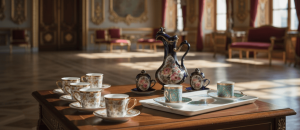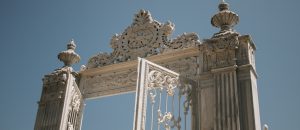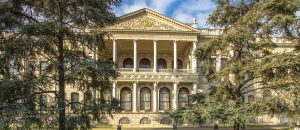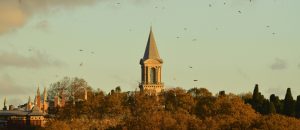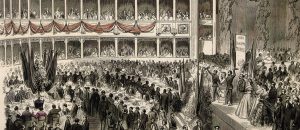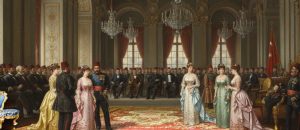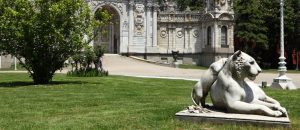Photographing Dolmabahçe Palace is not just about collecting beautiful memories, but also about visually narrating the greatest transformation story of an empire. Every frame you capture can reflect one of the palace’s strategic messages—Westernization, grandeur, simplicity, or symmetry. Instead of merely “taking” the moment like a tourist, capturing frames that will “tell” the story, thinking like a curator, will both make your visit more meaningful and your social media shares more impressive. Here are special shooting spots and techniques for photographing Dolmabahçe Palace like a curator. (Remember: Using flash inside the Palace is strictly prohibited!).
1. Story: Symmetry and Order (The Spirit of Tanzimat)
Message: Tell the story of the Ottoman Empire transforming into a rational, ordered, and modern state.
Where to Shoot?:
The Sultanate Gate (Exterior Shot): Stand directly opposite the gate and center it in your frame. Emphasize the perfect symmetry of the architectural details on the right and left sides of the gate. This frame is the entrance gate of the empire’s “new order”.
The Entrance of the Ceremonial Hall (Interior Shot): Stand exactly in the middle of the doorway before entering the hall. A shot taken from here combines the depth of the hall, the symmetrical arrangement of the columns on both sides, and the section where the Sultan’s throne is placed directly opposite, all in one frame. This is the most powerful visual expression of the rational spirit of Tanzimat.
Technical Tip: To strengthen the symmetry, turn on the gridlines feature on your phone or camera and align the main axis precisely with the vertical line.
2. Story: Scale and Grandeur (A Show of Force)
Message: Convey the feeling of human smallness against the magnitude and wealth of the empire.
Where to Shoot?:
The Crystal Staircase (Interior Shot): Take a wide-angle shot upwards from the bottom step of the staircase. While the ceiling of the staircase and the Baccarat crystal railings cover a large part of your frame, try to include the silhouette of a person standing on the upper floor. This demonstrates the overwhelming effect of the architecture on humans.
The Ceremonial Hall (Interior Shot): Move to one of the corners of the hall and aim your camera upwards to include the giant chandelier in the dome. Use a wide angle to fit both the chandelier and the overall size of the hall into a single frame. This frame is the summary of the empire’s grandeur in its final period.
Technical Tip: To emphasize the sense of scale, make a comparison by placing a human figure next to a large architectural element (door, column, chandelier).
3. Story: Texture and Detail (Art and Craftsmanship)
Message: Explain that the palace is not just a large structure, but also an incredible treasure of handiwork and art.
Where to Shoot?:
The Hereke Carpet in the Hall of Ambassadors (Interior Shot): From a permitted distance, focus on the patterns and texture of the carpet by bending down to the floor. Establish the relationship between detail and the whole by shooting one corner of the carpet along with the leg of a piece of furniture in the room.
The Sultan’s Bath (Interior Shot): Focus on the veined and translucent texture of the water marble (alabaster) brought from Egypt. Try to capture how the light filters through this marble. This is the most beautiful example of the palace’s use of luxurious materials.
Technical Tip: Get as close to the object as possible for detail shots (but do not touch!). Using Portrait mode to blur the background makes the detail stand out more.
4. Story: Contrast (Empire vs. Republic)
Message: Narrate how the palace houses two different eras—the Empire and the Republic—together.
Where to Shoot?:
Atatürk’s Room (Interior Shot): The most powerful shot in the room is the photograph taken directly opposite the bed, centering the bed and the Turkish flag draped over it. You can create the strongest contrast by sharing this simplicity side-by-side with the grandeur of the Ceremonial Hall you photographed just before.
Shot from the Quay (Exterior Shot): Stand on the palace quay (pier). Combine the magnificent facade of the palace on one side, and a modern city line ferry or a cargo ship passing through the Bosphorus on the other, in the same frame. This is a symbolic frame narrating how the imperial heritage coexists with the vibrant life of the modern Republic.
Technical Tip: Use colors, textures, and meanings to create contrast. Like combining a photograph of a detailed gold-leaf ceiling with the simple wooden bed in Atatürk’s room.
Conclusion: Let Your Photo Be Your Story
When you photograph Dolmabahçe Palace with this curatorial perspective, you will have not just beautiful pictures, but also a meaningful visual narrative. Every symmetry frame you capture will tell the story of the Tanzimat, every grandeur frame the assertion of the empire, every detail frame its art, and every contrast frame the heritage of the Republic. Capture the moment, but more importantly, tell the great story behind that moment.








